RED-S
Coach Ryan, writes, for those of you that watched the Tour de France this year you may remember Norwegian rider Jonas Abrahamsen off the front in the breakaways and leading the KOM and Sprint Classifications at various points of the race. For Abrahamsen, these are the best results of his career despite putting on 20kg (40lbs), which for many cyclists is unbelievable. When you look into his story Abrahamsen showed the classic symptoms of Relative Energy Deficiency in Sport (RED-S) which more than likely had an impact on his performance and health.
RED-S is a syndrome that can have quite severe health and performance effects. RED-S refers to an impaired physiological function “including, but not limited to, metabolic rate, menstrual function, bone health, immunity, protein synthesis and cardiovascular health” (Mountjoy et al. 2014). The cause of RED-S is a sustained deficiency in the amount of energy taken in and the energy required for daily living, growth, and sporting activities leading to low energy availability. In other words, not taking in enough energy compared to what you are using over an extended period of time.
Unfortunately, in many sports especially endurance sports like cycling, running and triathlon a focus on weight has led to many athletes under fuelling to their detriment. In one study by Rogers et al. (2020) they found that 80% of the 112 participants had one symptom consistent with RED-S and 37% had two or three symptoms. Similar results were found by Marzuki et al. (2023) in 18-39 year old Malaysian athletes where 67.2% of athletes were classified as having a medium/ high risk of RED-S.
You also don’t need to be an elite athlete to run the risk of under fuelling and developing the symptoms of RED-S. In 2019, I conducted research into the performance effects of RED-S on exercise economy, VO2max and lactate threshold with the original aim to base the study on local non-elite ‘everyday’ triathletes. However, so many athletes showed signs of RED-S it was difficult to find enough participants for the control (non-RED-S) group so I had to expand the subject pool to other sports.
With RED-S being so common in sport, you may be wondering “do I have RED-S?” There are a few different methods that are used to determine the risk of someone having RED-S. But for several reasons (which I’ll talk about below) there is no one current gold standard. The first method is using questionnaires such as the LEAF-Q or the IOC REDs CAT2 to screen for risk factors associated with RED-S. While these questionnaires are relatively easy to complete, they only measure likelihood and risk, not whether you actually have RED-S. The second method is to count the calories you burn vs the calories you take in. This is tricky as it relies on you tracking everything accurately and being able to figure out how many calories are actually in your food. Which can be especially difficult if you cook food from scratch. The third method is through a combination of clinical assessments such as blood tests, DEXA scans and measured resting metabolic rate vs predicted metabolic rate. While generally, this is the most accurate method it is also the most expensive and can be invasive.
Because of the difficulties associated with the methods of assessing RED-S, I always recommend people talk to a professional to help determine the best method for them. This could be your coach, a nutritionist or a doctor. This is especially important if you show some of the key symptoms which are repeated bone stress injuries, unexpected weight loss, disordered eating, lack of normal growth/ development (in children), mood changes and decreased performance. In females there is also a key symptom to look out for which is irregular or non-existent periods. Many athletes I have talked to don’t realise this isn’t normal and is the number one sign of RED-S in females.
There are many more things I could discuss regarding RED-S and low energy availability and sport. However, this article is already starting to get a bit long and this is my first post for CycleCoach so I will leave it here for now. If you have any questions or a specific area you would like me to discuss further you can contact me via DM on Instagram @RyanAllenCoaching or by sending an email to ryan@cyclecoach.com. If enough people want more information on a particular area, I might be able to convince head coach Ric to let me write a part 2 so don’t be afraid to ask any questions you might have about this or any other sports science topic.
Marzuki, M. I., Mohamad, M. I., Chai, W. J., Farah, N. M., Safii, N. S., Jasme, J. K., & Jamil, N. A. (2023). Prevalence of relative energy deficiency in sport (red-S) among national athletes in Malaysia. Nutrients, 15(7), 1697. https://doi.org/10.3390/nu15071697
Mountjoy, M., Sundgot-Borgen, J., Burke, L., Carter, S., Constantini, N., Lebrun, C., Meyer, N., Sherman, R., Steffen, K., Budgett, R., & Ljungqvist, A. (2014). The IOC consensus statement: Beyond the female athlete triad—relative energy deficiency in sport (red-S). British Journal of Sports Medicine, 48(7), 491–497. https://doi.org/10.1136/bjsports-2014-093502
Rogers, M. A., Appaneal, R. N., Hughes, D., Vlahovich, N., Waddington, G., Burke, L. M., & Drew, M. (2020). Prevalence of impaired physiological function consistent with relative energy deficiency in sport (red-S): An Australian elite and pre-elite cohort. British Journal of Sports Medicine, 55(1), 38–45. https://doi.org/10.1136/bjsports-2019-101517
